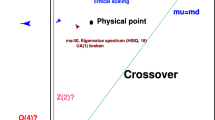Summary
Anisotropic chromodynamics (ACD), a color gauge theory on a postulated anisotropic space-time proposed long ago, is seen to emerge as the effective theory of quarks and gluons on what most likely is the QCD ground state, the chromo magnetic liquid (CML). A description of both the kinematics and dynamics of ACD is presented, and a possible strategy for a systematic calculation of hadronic physics is outlined.
Similar content being viewed by others
References
G. Preparata:Phys. Lett. B,102, 327 (1981).
Contrary to a widely held opinion, this research program has never questioned the validity of the basic QCD Lagrangian. It only departed from the generally accepted picture of QCD, which pretends that confinement does not play any role at short distances.
D. Gross andF. Wilczek:Phys. Rev. Lett.,30, 1342 (1973);H. D. Politzer:Phys. Rev. Lett.,30, 1346 (1973).
For a recent review seeG. Preparata:The magnetic instability of the perturbative Yang-Mills vacuum, inVariational Calculations in Quantum Field Theory, edited byL. Polley andD. E. L. Pottinger (World Scientific, Singapore, 1988).
An early—and only—criticism byL. Maiani et al.:Nucl. Phys. B,273, 275 (1986), was rebutted inG. Preparata:Nuovo Cimento A,96, 394 (1986) and more recently with different arguments has been dismissed byP. Castorina andM. Consoli:Phys. Lett. B,213, 493 (1988).
J. Ashman et al.:Phys. Lett. B,206, 364 (1988).
G. Preparata:Nucl. Phys. B.,279, 235 (1987).
G. K. Savvidy:Phys. Lett. B,71, 133 (1977).
G. Preparata:Nuovo Cimento A,96, 366 (1986).
L. Cosmai andG. Preparata:Phys. Rev. Lett.,57, 2613 (1986).
G. Preparata:Phys. Lett. B,201, 139 (1988).
H. B. Nielsen andP. Olesen:Nucl. Phys. B,160, 380 (1979).
It should be stressed that in its original formulation ACD didnot include dynamical (transverse) gluons. The existence of these unexpected dynamical degrees of freedom is a new important consequence of the magnetic condensation phenomenon that leads to the CML.
J. L. Basdevant andG. Preparata:Nuovo Cimento A,67, 19 (1982);J. L. Basdevant, P. Colangelo andG. Preparata:Nuovo Cimento A,71, 445 (1982).
G. Preparata: in preparation.
S. Mattina andG. Preparata: in preparation.
The solution of this problem requires the correct definition of the single hadron matrix elements of electroweak currents.
See, for instance,G. Preparata: inProceedings of the 1984 SLAC Summer Institute (Stanford, 1985).
Author information
Authors and Affiliations
Rights and permissions
About this article
Cite this article
Preparata, G. Anisotropic chromodynamics and the QCD ground state. Nuov Cim A 103, 1073–1083 (1990). https://doi.org/10.1007/BF02782741
Received:
Published:
Issue Date:
DOI: https://doi.org/10.1007/BF02782741




